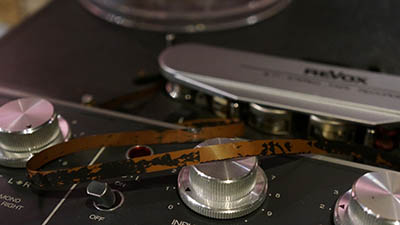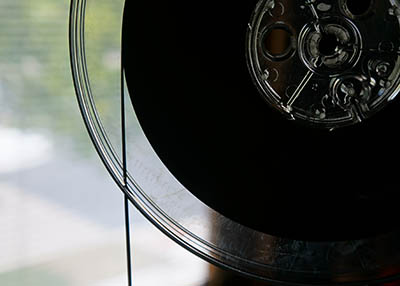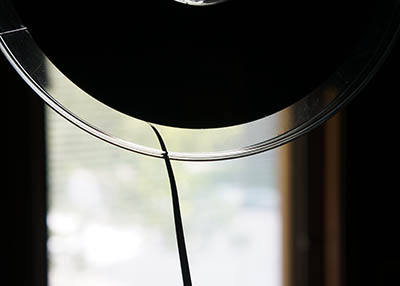/>Patty tape, patty tape, AV Man
Bake me a tape as fast as you can…
"If you have Ampex tape, we're probably going to have to bake it."
If you have old video or audio tapes laying around in damp basements or closets – particularly if they were "high output" tapes from the late 70s and beyond – and especially those made by Ampex (and some 3M formulations) they very likely have “Sticky Shed Syndrome.” That’s what happens when the tape layers start to stick to each other, and if you play them, they "shed," gunking up the heads and tape guides. You will hear loss of high frequencies, possibly a squeal from the tape guides, and deposits may even bring playback, literally, to a screeching halt.
To understand sticky shed you need to understand how tape is made. Magnetic tape (whether used for audio or video) has at least two, and sometimes three layers:
- The BASE is a transparent plastic ribbon that’s very thin. In open reel and cassette audiotapes the thickness varies to fit more tape on a reel. The base defines the tape width. For open reel tapes it's usually 1/4," cassettes 1/8," and for VCR tapes, 1/2." (Pro recording studios used tape up to 2" in width, but we can't transfer those.) There are two types of base, acetate and polyester, and sticky shed is most commonly found with the latter.
- The OXIDE is one of many formulations of iron oxide or exotic metals that are adhered to the base with a glue called the BINDER. The oxide stores the magnetic pulses created during recording that the playback head reads to recreate the sound or the picture. The oxide was usually formulated with a lubricant to reduce wear on the tape heads.
- BACKCOATING is the 3rd layer that was added to tapes starting in the late 70s. It’s typically a flat black coating that’s supposed to help reduce print-through (a faint echo where the magnetic patterns imprint themselves on adjacent layers of tape on the reel), and provide lubrication for guides that ride on the back of the tape. This too is adhered to the base with a binder.
 The problem is that with normal humidity on poorly formulated tapes, the binder glue absorbs moisture from the air and turns either the oxide or the backcoating (or both) into goo! In mild cases you may start to hear a progressive loss of high frequencies as the playback head becomes clogged, or you'll hear a screeching sound from the tape guides. In worst-case scenarios, the backcoating can adhere to the oxide of the adjoining layer and actually peel it off, destroying the tape entirely (see photo).
The problem is that with normal humidity on poorly formulated tapes, the binder glue absorbs moisture from the air and turns either the oxide or the backcoating (or both) into goo! In mild cases you may start to hear a progressive loss of high frequencies as the playback head becomes clogged, or you'll hear a screeching sound from the tape guides. In worst-case scenarios, the backcoating can adhere to the oxide of the adjoining layer and actually peel it off, destroying the tape entirely (see photo).
Sticky Shed and Open Reel Tapes
If you have an open reel tape, it’s easy to tell if it has sticky shed: just hold the reel up on its edge and let some of the tape fall off on one side. If the tape falls freely as you unroll it, and it comes off on a perfect tangent (straight down), your tape is OK. Wind it back up and it can be transferred normally.
 If the tape sticks to the tape pack and comes down curved, you have sticky shed. The more it sticks to the pack, the worse it is. If it’s really bad the tape may even feel tacky. If it peels apart (like the photo of peeling tape above), stop and wind it back up immediately! We can't rescue it if the oxide peels off.
If the tape sticks to the tape pack and comes down curved, you have sticky shed. The more it sticks to the pack, the worse it is. If it’s really bad the tape may even feel tacky. If it peels apart (like the photo of peeling tape above), stop and wind it back up immediately! We can't rescue it if the oxide peels off.
 Even if the tape falls freely, you may still have sticky shed deeper in the tape pack. If you experience a loss of high frequencies as the tape plays, or the tape slows, chatters, squeals, or won't fast wind, leaving residue on the heads or guides, it has sticky shed. Stop playback immediately and wind it back directly between the reels (not touching the guides) to prevent further damage.
Even if the tape falls freely, you may still have sticky shed deeper in the tape pack. If you experience a loss of high frequencies as the tape plays, or the tape slows, chatters, squeals, or won't fast wind, leaving residue on the heads or guides, it has sticky shed. Stop playback immediately and wind it back directly between the reels (not touching the guides) to prevent further damage.
Sticky Shed and Cassettes (Audio or Video)
If you have a videocassette or audio cassette, it’s a bit tougher to detect because you can’t touch the tape inside the shell. If you hear a squeal or chattering from the machine, or the playback slows or stops, the tape probably has sticky shed. Don’t play it any farther because you could damage it. Your machine will need a good cleaning before putting in any more tapes, because the residue can damage a good tape. (For a VCR that means opening it up and cleaning the tape guides and tension posts with alcohol and a cotton swab, something cleaning tapes can't do.) Here's a before/after example of a videotape with sticky shed that we restored:
Tape Baking: The (Temporary) Cure for Sticky Shed
What we have to do is to "bake" the moisture out of the tape before it can be played.
Well we don’t put them in a real oven, but we use a special dehydrator which heats the tape at a temperature that won’t melt or distort the plastic. It takes upwards of 48 hours to make the tape playable, and then we have only a few hours to make the digital transfer before it starts to get sticky again. It may be the last time the tape can ever be played.
So. if you bring us a tape, video or audio, we’ll check it for sticky shed, and if it’s there we’ll start the baking process. It’s an extra cost option, but well worth it to preserve the precious memories locked on that tape.
Prefer the Experience of Playing Tape?
Note that tape baking is a temporary solution. We only have a few hours to transfer the tape before it turns to goo again. If you are an audiophile who likes to play tapes (like me), we can transfer the baked tape to digital, then copy it back to fresh audio tape. You can keep the reels spinning!
Dry Shed
The opposite of Sticky Shed is Dry Shed. We've seen this in old, private branded tapes from the 60's and earlier - usually with acetate base. It's where the binder glue simply dries out. As you play the tape the oxide literally flakes off as the tape passes through the tape guides. Usually it's spotty, so the tape sounds fine as it's played, until you hear dropouts. Then we look at the tape recorder and see oxide flakes around machine. If you look at the tape where a dropout occurred, you'll see no oxide - just clear plastic where the flakes fell off, and the flakes are dry to the touch, not sticky. That's the program, lying on the floor, unable to be restored.
There's no real cure for Dry Shed as there is for Sticky Shed - tape baking won't work, and will damage acetate based tapes. Just know that the tape will get worse over time, so you need to get old tapes digitized before the memories turn to brown powder. If we encounter dry shed, we'll let you know there may be dropouts. Fortunately it's rare that a dropout affects both channels of a tape, so the memories may not be totally lost in transfer.
Time is running out!!!
Tapes don't last forever. For some there's little time left to preserve them. Tape baking is a services that the “box” mass marketed digitizing firms don’t offer, but we do. Make Advent Media, Inc. your first choice in digital transfers.
Click below to start:
Tape Restoration Starts Here